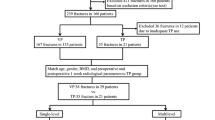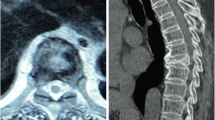Abstract
Summary
We conducted a prospective comparative study of the effect of teriparatide therapy for preventing vertebral-failure-type PJK after reconstructive surgery for adult spinal deformity. Prophylactic teriparatide improved the volumetric bone mineral density and fine bone structure of the vertebra above the upper-instrumented vertebra and reduced the incidence of vertebral-failure-type PJK.
Introduction
Proximal junctional kyphosis (PJK) is a complication after corrective surgery for spinal deformity. This study sought to determine whether teriparatide (TP) is an effective prophylactic against PJK type 2 (vertebral fracture) in surgically treated patients with adult spinal deformity (ASD).
Methods
Forty-three patients who started TP therapy immediately after surgery and 33 patients who did not receive TP were enrolled in this prospective case series. These patients were female, over 50, surgically treated for ASD, and followed for at least 2 years. Preoperative and postoperative standing whole-spine X-rays and dual-energy X-ray absorptiometry scans, and multidetector CT images obtained before and 6 months after surgery were used to analyze the bone strength in the vertebra above the upper-instrumented vertebra (UIV+1).
Results
Mean age was 67.9 years. After 6 months of treatment, mean hip-bone mineral density (BMD) increased from 0.721 to 0.771 g/cm2 in the TP group and decreased from 0.759 to 0.729 g/cm2 in the control group. This percent BMD change between groups was significant (p < 0.05). The volumetric BMD (326 to 366 mg/cm3) and bone mineral content (BMC) (553 to 622 mg) at UIV+1 were also significantly increased in TP group. The bone volume/tissue volume ratio increased from 46 to 54 % in the TP group, and the trabecular bone thickness and number increased by 14 and 5 %, respectively. At the 2-year follow-up, the PJK type 2 incidence was significantly lower in the TP group (4.6 %) than in the control group (15.2 %; p = .02).
Conclusions
Prophylactic TP treatment improved the volumetric BMD and fine bone structure at UIV+1 and reduced the PJK-type 2 incidence.

Similar content being viewed by others
References
Kim YJ, Lenke LG, Bridwell KH et al (2007) Proximal junctional kyphosis in adolescent idiopathic scoliosis after 3 different types of posterior segmental spinal instrumentation and fusions: incidence and risk factor analysis of 410 cases. Spine (Phila Pa 1976) 32:2731–8
Lee GA, Betz RR, Clements DH 3rd et al (1999) Proximal kyphosis after posterior spinal fusion in patients with idiopathic scoliosis. Spine (Phila Pa 1976) 24:795–9
DeWald CJ, Stanley T (2006) Instrumentation-related complications of multilevel fusions for adult spinal deformity patients over age 65: surgical considerations and treatment options in patients with poor bone quality. Spine (Phila Pa 1976) 31:S144–51
Hart RA, Prendergast MA, Roberts WG et al (2008) Proximal junctional acute collapse cranial to multi-level lumbar fusion: a cost analysis of prophylactic vertebral augmentation. Spine J 8:875–81
Kim YJ, Bridwell KH, Lenke LG et al (2008) Proximal junctional kyphosis in adult spinal deformity after segmental posterior spinal instrumentation and fusion: minimum five-year follow-up. Spine (Phila Pa 1976) 33:2179–84
Kim YJ, Bridwell KH, Lenke LG et al (2005) Proximal junctional kyphosis in adolescent idiopathic scoliosis following segmental posterior spinal instrumentation and fusion: minimum 5-year follow-up. Spine (Phila Pa 1976) 30:2045–50
Yang SH, Chen PQ (2003) Proximal kyphosis after short posterior fusion for thoracolumbar scoliosis. Clin Orthop Relat Res 152–8.
Helgeson MD, Shah SA, Newton PO et al (2010) Evaluation of proximal junctional kyphosis in adolescent idiopathic scoliosis following pedicle screw, hook, or hybrid instrumentation. Spine (Phila Pa 1976) 35:177–81
Hollenbeck SM, Glattes RC, Asher MA et al (2008) The prevalence of increased proximal junctional flexion following posterior instrumentation and arthrodesis for adolescent idiopathic scoliosis. Spine (Phila Pa 1976) 33:1675–81
Watanabe K, Lenke LG, Bridwell KH et al (2010) Proximal junctional vertebral fracture in adults after spinal deformity surgery using pedicle screw constructs: analysis of morphological features. Spine (Phila Pa 1976) 35:138–45
Lowe TG, Kasten MD (1994) An analysis of sagittal curves and balance after Cotrel-Dubousset instrumentation for kyphosis secondary to Scheuermann’s disease. A review of 32 patients. Spine (Phila Pa 1976) 19:1680–5
Glattes RC, Bridwell KH, Lenke LG et al (2005) Proximal junctional kyphosis in adult spinal deformity following long instrumented posterior spinal fusion: incidence, outcomes, and risk factor analysis. Spine (Phila Pa 1976) 30:1643–9
Good CR, Lenke LG, Bridwell KH et al (2010) Can posterior-only surgery provide similar radiographic and clinical results as combined anterior (thoracotomy/thoracoabdominal)/posterior approaches for adult scoliosis? Spine (Phila Pa 1976) 35:210–8
Yagi M, King A, Boachie-Adjei O (2011) Incidence, risk factors and classification of proximal junctional kyphosis: surgical outcomes review of adult idiopathic scoliosis. Spine (Phila Pa 1976) 36(1):60–8
Yagi M, King AB, Boachie-Adjei O (2012) Incidence, risk factors, and natural course of proximal junctional kyphosis: surgical outcomes review of adult idiopathic scoliosis. Minimum 5 years of follow-up. Spine (Phila Pa 1976) 37(17):1479–89
Yagi M, Rahm M, Gaines R et al (2014) Characterization and surgical outcomes of proximal junctional failure (PJF) in surgically treated adult spine deformity patients. Spine (Phila Pa 1976) 39:E607–14
Yagi M, Hosogane N, Okada E et al (2014) Factors affecting the post operative progression of thoracic kyphosis in surgically treated adult patient with lumbar degenerative scoliosis. Spine (Phila Pa 1976) 39:E521–8
Yagi M, Patel R, Lawhorne TW et al (2013) Adult thoracolumbar and lumbar scoliosis treated with long vertebral fusion to the sacropelvis: a comparison between new hybrid selective spinal fusion versus anterior-posterior spinal instrumentation. The Spine J 14:637–45
Yagi M, Cunningham E, King A et al (2013) Long term clinical and radiographic outcomes of pedicle subtraction osteotomy for fixed sagittal imbalance: does level of proximal fusion affect the outcome?—minimum 5years follow-up. Spine Deformity 1:123–31
Yagi M, King AB, Boachie-Adjei O (2011) Characterization of osteopenia/osteoporosis in adult scoliosis: does bone density affect surgical outcome? Spine (Phila Pa 1976) 36(20):1652–7
Munemoto M, Kido A, Sakamoto Y et al (2016) Analysis of trabecular bone microstructure in osteoporotic femoral heads in human patients: in vivo study using multidetector row computed tomography. BMC Musculoskelet Disord 17(1):13
Krege J, Lane N, Harris J et al (2014) PINP as a biological response marker during teriparatide treatment for osteoporosis. Osteoporos Int 25(9):2159–2171
Croucher P, Garrahan N, Compston J (1996) Assessment of cancellous bone structure: comparison of strut analysis, trabecular bone pattern factor, and marrow space star volume. J Bone Miner Res 11(7):955–61
Yakacki CM, Poukalova M, Guldberg RE et al (2010) The effect of the trabecular microstructure on the pullout strength of suture anchors. J Biomech 43(10):1953–9
Inoue K, Hamano T, Nango N et al (2014) Multidetector-row computed tomography is useful to evaluate the therapeutic effects of bisphosphonates in glucocorticoid-induced osteoporosis. J Bone Miner Metab 32(3):271–80
Lochmüller EM, Bürklein D, Kuhn V et al (2002) Mechanical strength of the thoracolumbar spine in the elderly: prediction from in situ dual-energy X-ray absorptiometry, quantitative computed tomography (QCT), upper and lower limb peripheral QCT, and quantitative ultrasound. Bone 31(1):77–84
Ito M, Ikeda K, Nishiguchi M et al (2005) Multi-detector row CT imaging of vertebral microstructure for evaluation of fracture risk. J Bone Miner Res 20(10):1828–36
Murad MH, Drake MT et al (2012) Clinical review. Comparative effectiveness of drug treatments to prevent fragility fractures: a systematic review and network meta-analysis. J Clin Endocrinol Metab 97(6):1871–80
Cortet B, Colin D, Dubois P et al (1995) Methods for quantitative analysis of trabecular bone structure. Rev Rhum Engl Ed 62(11):781–93, Review
Eckstein F, Lochmüller EM, Lill CA et al (2002) Bone strength at clinically relevant sites displays substantial heterogeneity and is best predicted from site-specific bone densitometry. J Bone Miner Res 17(1):162–71
Kim YJ, Bridwell KH, Lenke LG et al (2007) Is the T9, T11, or L1 the more reliable proximal level after adult lumbar or lumbosacral instrumented fusion to L5 or S1? Spine (Phila Pa 1976) 32:2653e61
Kebaish KM, Martin CT, O’Brien JR et al (2013) Use of vertebroplasty to prevent proximal junctional fractures in adult deformity surgery: a biomechanical cadaveric study. Spine J 13(12):1897–903
Hildebrand T, Rüegsegger P (1997) Quantification of bone microarchitecture with the Structure Model Index. Comput Methods Biomech Biomed Engin 1(1):15–23
Vesterby A (1990) Star volume of marrow space and trabeculae in iliac crest: sampling procedure and correlation to star volume of first lumbar vertebra. Bone 11(3):149–55
Vesterby A (1993) Star volume in bone research. A histomorphometric analysis of trabecular bone structure using vertical sections. Anat Rec 235(2):325–34
Hahn M, Vogel M, Pompesius-Kempa M et al (1992) Trabecular bone pattern factor—a new parameter for simple quantification of bone microarchitecture. Bone 13(4):327–30
Hong Jae K, Hyun C, Heung Kook C Region-position 3D labeling algorithm for three dimensional analysis of cells. Enterprise networking and Computing in Healthcare Industry, 2005. HEALTHCOM 2005. Proceedings of 7th International Workshop on:388–9
Kanda Y (2013) Investigation of the freely available easy-to-use software ‘EZR’ for medical statistics. Bone Marrow Transplant 48(3):452–8
Chen JF, Yang KH, Zhang ZL et al (2015) A systematic review on the use of daily subcutaneous administration of teriparatide for treatment of patients with osteoporosis at high risk for fracture in Asia. Osteoporos Int 26(1):11–28
Baum T, Gräbeldinger M, Räth C et al (2014) Trabecular bone structure analysis of the spine using clinical MDCT: can it predict vertebral bone strength? J Bone Miner Metab 32(1):56–64
Author information
Authors and Affiliations
Corresponding author
Ethics declarations
This study was approved by the appropriate institutional review board.
Conflicts of interest
None.
Rights and permissions
About this article
Cite this article
Yagi, M., Ohne, H., Konomi, T. et al. Teriparatide improves volumetric bone mineral density and fine bone structure in the UIV+1 vertebra, and reduces bone failure type PJK after surgery for adult spinal deformity. Osteoporos Int 27, 3495–3502 (2016). https://doi.org/10.1007/s00198-016-3676-6
Received:
Accepted:
Published:
Issue Date:
DOI: https://doi.org/10.1007/s00198-016-3676-6




